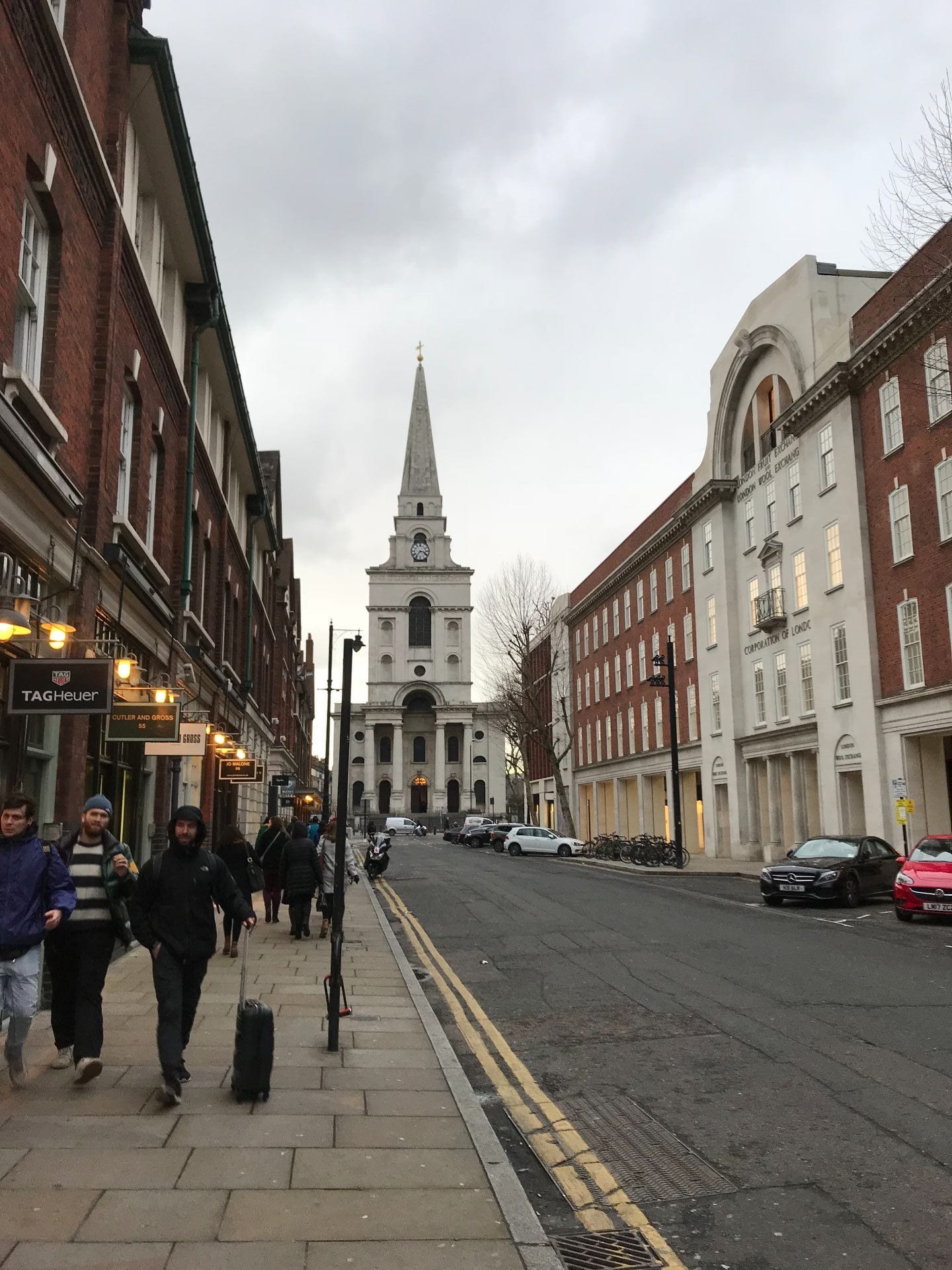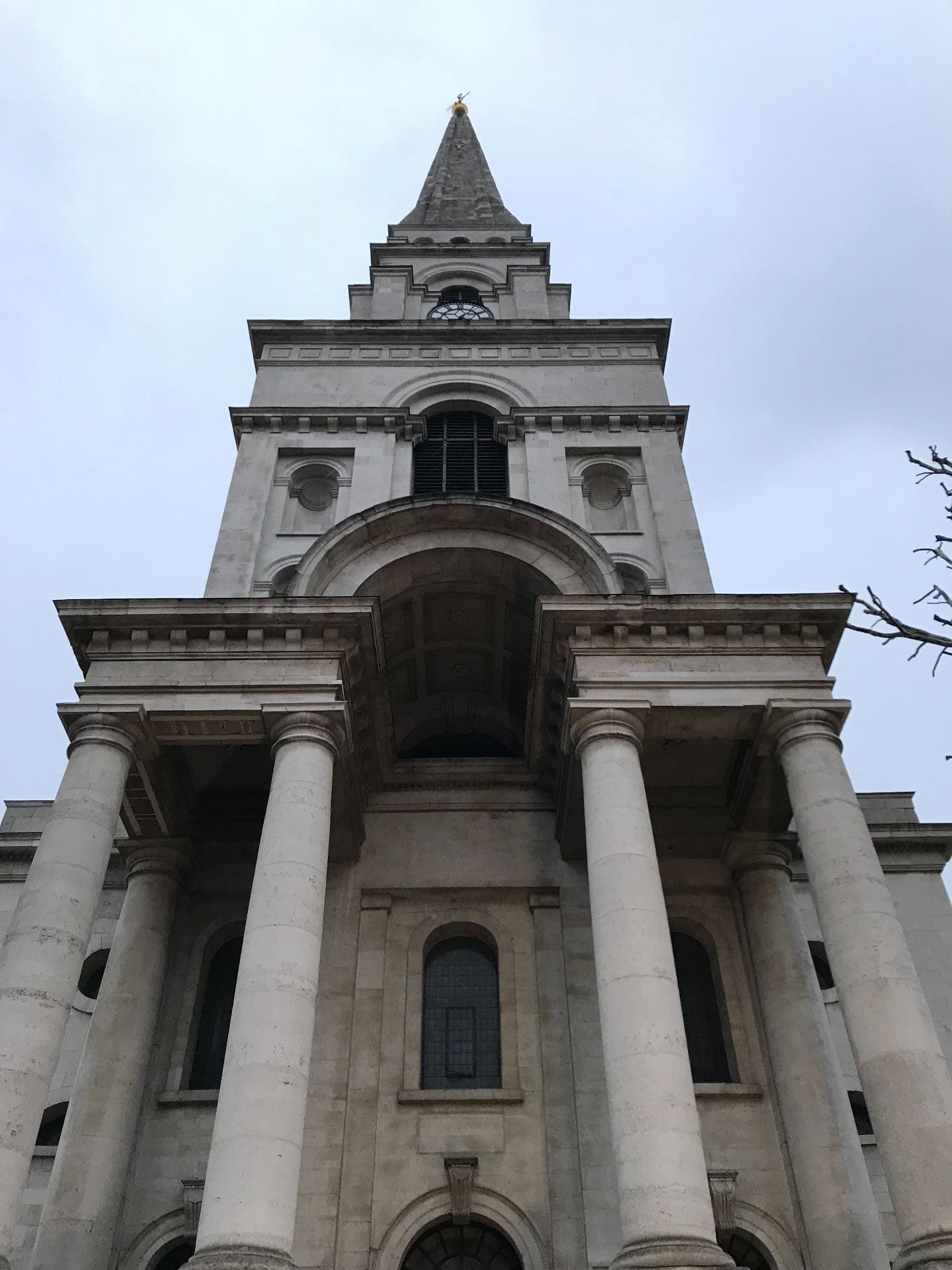Spellbound in Spitalfields: Hawksmoor’s Christ Church
By James Kelleher, WPAMC Class of 2020
Note: This post describes experiences I had over Winterthur’s British Design History field study. I, as well as all the other field study students, have written a separate series of posts specifically about the field study that will appear in the coming weeks.
At this point it’s almost cliché for me to write about English Baroque architect Nicholas Hawksmoor. Over the past hundred years or so, his reputation has undergone a considerable reappraisal in his favor. There is very little for me to add from a scholarly or critical angle. Fortunately for all of us, buildings don’t melt into air after they’re well studied. They continue to leave an impression on those who encounter them. Sometimes the impressions are shrugged off and easily forgotten, like the corner store or boilerplate apartment complexes. Sometimes, though, a building is absolutely magnetic. Christ Church, Spitalfields is one such building.
Christ Church stuck in my head like a song. I remember, during our walking tour of East London, turning right onto Brushfield Street, facing east, and being completely struck by the church’s façade. Brushfield street is just shy of a quarter mile long, and Christ Church commands every foot of it. There’s a high rise on the north side of the street, probably taller than the church’s spire. It doesn’t matter. I’m not sure I even saw it. Most towers are taller than the churches to which they’re attached, but Christ Church’s is more than three times the height of the building’s body. Hawksmoor’s great illusion here is that from head-on, it looks like the tower is sitting directly on top of the portico’s four pillars. The main body of the tower itself is a modified triumphal arch, and it’s use on a tower is to my knowledge unprecedented. It’s an immense amount of visual weight to sit on top of a mostly void space, and the effect is that the tower seemingly leans over you, standing almost in spite of itself. Walking towards the church slowly breaks the effect, as you realize the tower is flush with the main body of the church and the portico projects out. It’s an impressive transfiguration that lends a real dynamism not only to the building, but to the entire walk down the street. All buildings move with the viewer, but few reorient themselves so dramatically. The tower that first pushed out so aggressively now takes a slight step back, beckoning you inside. We had only ten minutes or so to experience the interior, which deserves attention on its own merits. I knew I had to come back.
The following Sunday was a free day, with the caveat that we had to be in Oxford by evening. I had given myself a pretty full itinerary that started with Bevis Marks, London’s oldest synagogue, which was wonderful and welcoming with the justifiable caution of a locked and guarded gate. From there I walked towards Spitalfields on a route that took me through a flea market just as the wind was picking up and people were scrambling to pack up their stalls. I once again turned onto Brushfield street, and my now passing familiarity with the church didn’t diminish its impact a whit. I ambled towards the tower and decided to stop for lunch before going inside. As I sat working on a cheeseboard ostensibly meant for two, I couldn’t help looking down the empty bar, through the window and down the street at the church. This is what I mean by magnetism. It’s a building that I wanted to look at until I understood it.
This time, the interior was lit by a some shockingly violet spotlights left on from the midday services. Even in a surreal neon glow, it doesn’t disappoint. A giant composite order of pedestaled columns separates the nave from the aisles. They’re capped by cornices and barrel vaults that project into the space over the aisles, perpendicular to the long walls, as if extending from some other building that by pure chance intruded into this one. They are basically the central bay of the church’s portico turned inward and repeated, creating a surprising unity between entrance and interior. The flat roof, crisscrossed by patterned beams, appears held up by pilasters resting on a narrow cornice that itself rests on the projecting keystones of the aisle vaults. The pilasters are in line with the columns, but the vertical thrust is interrupted by the spandrels of the vaults. It’s a brief moment of complicated, calculated uneasiness where few people would think to look. Four columns mark the space between the nave and the altar, spanned by a continuous cornice that extends to the aisle walls, and creates an invisible, but palpable screen between the two spaces, between sacred and profane. I was the only person inside, so it was just me and the church. For reasons I can’t divine, I like to have my arms just a little outstretched when I’m trying to take in a big interior space. The fewer people to witness this, the better.
I’m not sure how long I spent inside. Eventually some people came to the came to the door and peered in, and I decided it was getting late enough to move on. That evening, by the time I had boarded the bus to Oxford, I had squeezed in two more buildings: Hawksmoor’s St. George in the East, and Inigo Jones’ Banqueting House. Both were marvelous. Neither stunned me like Christ Church. For the rest of the trip, I couldn’t get the church out of my head. I still can’t. It’s a testament to the continuing power of some buildings to grip those who experience them.




Leave a Reply